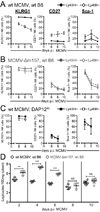Markers of nonselective and specific NK cell activation
- PMID: 23656738
- PMCID: PMC3679313
- DOI: 10.4049/jimmunol.1202533
Markers of nonselective and specific NK cell activation
Abstract
NK cell activation is controlled by the integration of signals from cytokine receptors and germline-encoded activation and inhibitory receptors. NK cells undergo two distinct phases of activation during murine CMV (MCMV) infection: a nonselective phase mediated by proinflammatory cytokines and a specific phase driven by signaling through Ly49H, an NK cell activation receptor that recognizes infected cells. We sought to delineate cell surface markers that could distinguish NK cells that had been activated nonselectively from those that had been specifically activated through NK cell receptors. We demonstrated that stem cell Ag 1 (Sca-1) is highly upregulated during viral infections (to an even greater extent than CD69) and serves as a novel marker of early, nonselective NK cell activation. Indeed, a greater proportion of Sca-1(+) NK cells produced IFN-γ compared with Sca-1(-) NK cells during MCMV infection. In contrast to the universal upregulation of Sca-1 (as well as KLRG1) on NK cells early during MCMV infection, differential expression of Sca-1, as well as CD27 and KLRG1, was observed on Ly49H(+) and Ly49H(-) NK cells late during MCMV infection. Persistently elevated levels of KLRG1 in the context of downregulation of Sca-1 and CD27 were observed on NK cells that expressed Ly49H. Furthermore, the differential expression patterns of these cell surface markers were dependent on Ly49H recognition of its ligand and did not occur solely as a result of cellular proliferation. These findings demonstrate that a combination of Sca-1, CD27, and KLRG1 can distinguish NK cells nonselectively activated by cytokines from those specifically stimulated through activation receptors.
Figures





Similar articles
-
Cytokine-Mediated Activation of NK Cells during Viral Infection.J Virol. 2015 Aug;89(15):7922-31. doi: 10.1128/JVI.00199-15. Epub 2015 May 20. J Virol. 2015. PMID: 25995253 Free PMC article.
-
Specific and nonspecific NK cell activation during virus infection.Nat Immunol. 2001 Oct;2(10):951-6. doi: 10.1038/ni714. Nat Immunol. 2001. PMID: 11550009
-
Dual Requirement of Cytokine and Activation Receptor Triggering for Cytotoxic Control of Murine Cytomegalovirus by NK Cells.PLoS Pathog. 2015 Dec 31;11(12):e1005323. doi: 10.1371/journal.ppat.1005323. eCollection 2015 Dec. PLoS Pathog. 2015. PMID: 26720279 Free PMC article.
-
Genetic control of innate immune responses against cytomegalovirus: MCMV meets its match.Genes Immun. 2002 Aug;3(5):250-62. doi: 10.1038/sj.gene.6363876. Genes Immun. 2002. PMID: 12140743 Review.
-
The impact of Ly49-NK cell-dependent recognition of MCMV infection on innate and adaptive immune responses.J Biomed Biotechnol. 2011;2011:641702. doi: 10.1155/2011/641702. Epub 2011 May 22. J Biomed Biotechnol. 2011. PMID: 21660138 Free PMC article. Review.
Cited by
-
Identification of Anti-tumor Cells Carrying Natural Killer (NK) Cell Antigens in Patients With Hematological Cancers.EBioMedicine. 2015 Aug 13;2(10):1364-76. doi: 10.1016/j.ebiom.2015.08.021. eCollection 2015 Oct. EBioMedicine. 2015. PMID: 26629531 Free PMC article.
-
Reliance on Cox10 and oxidative metabolism for antigen-specific NK cell expansion.Cell Rep. 2021 Jun 1;35(9):109209. doi: 10.1016/j.celrep.2021.109209. Cell Rep. 2021. PMID: 34077722 Free PMC article.
-
The role of KLRG1: a novel biomarker and new therapeutic target.Cell Commun Signal. 2024 Jun 19;22(1):337. doi: 10.1186/s12964-024-01714-7. Cell Commun Signal. 2024. PMID: 38898461 Free PMC article. Review.
-
NKp30 - A prospective target for new cancer immunotherapy strategies.Br J Pharmacol. 2020 Oct;177(20):4563-4580. doi: 10.1111/bph.15222. Epub 2020 Aug 26. Br J Pharmacol. 2020. PMID: 32737988 Free PMC article. Review.
-
Docosahexaenoic acid supplementation represses the early immune response against murine cytomegalovirus but enhances NK cell effector function.BMC Immunol. 2022 Apr 19;23(1):17. doi: 10.1186/s12865-022-00492-6. BMC Immunol. 2022. PMID: 35439922 Free PMC article.
References
-
- Biron CA, Byron KS, Sullivan JL. Severe herpesvirus infections in an adolescent without natural killer cells. N. Engl. J. Med. 1989;320:1731–1735. - PubMed
-
- Bukowski JF, Woda BA, Habu S, Okumura K, Welsh RM. Natural killer cell depletion enhances virus synthesis and virus-induced hepatitis in vivo. J. Immunol. 1983;131:1531–1538. - PubMed
-
- Brown MG, Dokun AO, Heusel JW, Smith HR, Beckman DL, Blattenberger EA, Dubbelde CE, Stone LR, Scalzo AA, Yokoyama WM. Vital involvement of a natural killer cell activation receptor in resistance to viral infection. Science. 2001;292:934–937. - PubMed
-
- Lee SH, Girard S, Macina D, Busà M, Zafer A, Belouchi A, Gros P, Vidal SM. Susceptibility to mouse cytomegalovirus is associated with deletion of an activating natural killer cell receptor of the C-type lectin superfamily. Nat. Genet. 2001;28:42–45. - PubMed
Publication types
MeSH terms
Substances
Grants and funding
LinkOut - more resources
Full Text Sources
Other Literature Sources
Molecular Biology Databases
Research Materials

